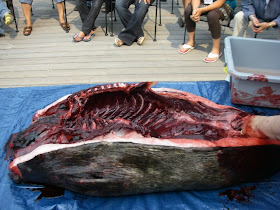
Here's Patty with an arm full of hat blanks and completed visors.
 Mike Livingston and I went down to Poppert's milling in Wasilla to get the wood for the hats. The picture above shows a big piece of cottonwood on the saw bed ready to be sliced into 3/8 inch thick slices. Cottonwood bends well, especially when still wet and green and is therefore a good material for hat blanks.
Mike Livingston and I went down to Poppert's milling in Wasilla to get the wood for the hats. The picture above shows a big piece of cottonwood on the saw bed ready to be sliced into 3/8 inch thick slices. Cottonwood bends well, especially when still wet and green and is therefore a good material for hat blanks.  Andrew Abyo was at the camp all week working on some full crowned hats. Here he is showing off some of his work, a visor and a mask. For more of his work, go to the Alutiiq museum site.
Andrew Abyo was at the camp all week working on some full crowned hats. Here he is showing off some of his work, a visor and a mask. For more of his work, go to the Alutiiq museum site.Here, Andrew is carving away on the blank for a full crowned hat.
 Patty had a picture of Andrew Gronholt set up. Andrew was her hat making teacher.
Patty had a picture of Andrew Gronholt set up. Andrew was her hat making teacher. Andrew's daughter, right in brown shirt is holding up one of her dad's hats and Patty is showing up a display board of miniature visors.
Andrew's daughter, right in brown shirt is holding up one of her dad's hats and Patty is showing up a display board of miniature visors. Here's the hat again.
Here's the hat again. Inside of the hat, showing construction details.
Inside of the hat, showing construction details. And a side view, showing the decorations.
And a side view, showing the decorations. Hat blanks heating up in a tub of boiling water.
Hat blanks heating up in a tub of boiling water. And a visor in the bending jig, drying till the shape sets.
And a visor in the bending jig, drying till the shape sets. Andrew is explaining various functional features of the Aleut hunting hat.
Andrew is explaining various functional features of the Aleut hunting hat. The hat funnels sound. Kids cup their hands to simulate sound amplification of the hat.
The hat funnels sound. Kids cup their hands to simulate sound amplification of the hat. Big pile of shavings left over from a week of hat carving.
Big pile of shavings left over from a week of hat carving.
Becky Bendixson with here completed full-crown hat.










